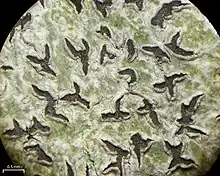Leiorreuma
Leiorreuma is a genus of script lichens in the family Graphidaceae. It has 18 species.[1] The genus was circumscribed by Franz Gerhard Eschweiler in 1824, with Leiorreuma hepaticum assigned as the type species.
| Leiorreuma | |
|---|---|
 | |
| Leiorreuma explicans | |
| Scientific classification | |
| Domain: | Eukaryota |
| Kingdom: | Fungi |
| Division: | Ascomycota |
| Class: | Lecanoromycetes |
| Order: | Graphidales |
| Family: | Graphidaceae |
| Genus: | Leiorreuma Eschw. (1824) |
| Type species | |
| Leiorreuma hepaticum Eschw. (1824) | |
Description
Leiorreuma is identified by certain features. It has apothecia with noticeable sessile opened lirellae. The proper exciple is often thin on the sides but well-developed at the base and appears charred. The hymenium is dotted with small specks, and the spores are pale brown and have thin walls with crosswise septa or are divided into many compartments (muriform). They are not stained by iodine.[2]
Species
- Leiorreuma convariatum (Kremp.) A.W.Archer (2007)
- Leiorreuma crassimarginatum Z.F.Jia (2015)[2] – China
- Leiorreuma dilatatum (Vain.) Staiger (2002)
- Leiorreuma ellipticum (Müll.Arg.) Staiger (2002)
- Leiorreuma erodens Seavey & J.Seavey (2017)[3] – Florida
- Leiorreuma exaltatum (Mont. & Bosch) Staiger (2002)
- Leiorreuma explicans (Fink) Lendemer (2008)
- Leiorreuma hepaticum Eschw. (1824)
- Leiorreuma hypomelaenoides Poengs. & Kalb (2014)[4] – Thailand
- Leiorreuma hypomelaenum (Müll.Arg.) Staiger (2002)
- Leiorreuma melanostalazans (Leight.) A.W.Archer (2005)
- Leiorreuma nicobarense Pushpi Singh, Jagadeesh and Kr.P.Singh (2017)[5] – India
- Leiorreuma nornotaticum (A.W.Archer & Elix) A.W.Archer (2005)
- Leiorreuma patellulum (Fée) Staiger (2002)
- Leiorreuma sericeum (Eschw.) Staiger (2002)
- Leiorreuma subpatellulum U.Dubey, Upreti & Nayaka (2010)[6] – India
- Leiorreuma taiwanense M.Nakan., Kashiw. & K.H.Moon (2008)[7] – Taiwan
- Leiorreuma vaginans (Zahlbr.) A.W.Archer (2007)
- Leiorreuma vicarians (Vain.) M.Nakan. & Kashiw. (2003)
- Leiorreuma yakushimense (M.Nakan.) M.Nakan. & Kashiw. (2003)[8] – Japan
References
- Wijayawardene, N.N.; Hyde, K.D.; Dai, D.Q.; Sánchez-García, M.; Goto, B.T.; Saxena, R.K.; et al. (2022). "Outline of Fungi and fungus-like taxa – 2021". Mycosphere. 13 (1): 53–453. doi:10.5943/mycosphere/13/1/2. S2CID 249054641.
- Wang, Xiao-Hua; Xu, Li-Li; Jia, Ze-Feng (2015). "The lichen genus Leiorreuma in China". Mycotaxon. 130 (1): 247–251. doi:10.5248/130.247.
- Seavey, F.; Seavey, J.; Gagnon, J.; Guccion, J.; Kaminsky, B.; Pearson, J.; Podaril, A.; Randall, B. (2017). "The lichens of Dagny Johnson Key Largo Hammock Botanical State Park, Key Largo, Florida, USA". Bulletin of the Florida Museum of Natural History. 53 (5): 201–268.
- Poengsungnoen, Vasun; Manoch, Leka; Mongkolsuk, Pachara; Kalb, Klaus (2014). "New species of Graphidaceae from Loei Province, Thailand". Phytotaxa. 189 (1): 255. doi:10.11646/phytotaxa.189.1.18.
- Singh, Pushpi; Ram, T.A.M. Jagadeesh; Singh, K.P. (2017). "A new species of Leiorreuma (Ascomycota, Ostropales) from Great Nicobar Island, India". Bangladesh Journal of Plant Taxonomy. 24 (1): 9–12. doi:10.3329/bjpt.v24i1.33000.
- Dubey, Urvashi; Upreti, Dalip K.; Nayaka, Sanjeeva (2010). "A new species of Leiorreuma Eschw. from India". The Lichenologist. 42 (6): 711–713. doi:10.1017/s002428291000040x. S2CID 87209802.
- Moon, Kwang Hee; Nakanishi, Minoru; Kashiwadani, Hiroyuki (2008). "Notes on species of Graphidaceae (Ascomycotina) from eastern Asia with three new species" (PDF). Bulletin of the National Museum of Nature and Science, Series B (Botany), Tokyo. 45: 85–91.
- Kashiwadani, Hiroyuki; Nakanishi, Minoru; Miyawaki, Hiromi; Takeshita, Shunji; Ohmura, Yoshihito; Tokizawa, Mika; Moon, Kwang Hee (2012). "Materials for the distribution of Lichens in Japan (19). Leiorreuma yakushimense (M. Nakan.) M. Nakan. & Kashiw. and Siphula decumbens Nyl". Journal of Japanese Botany. 87 (6): 408–411.
This article is issued from Wikipedia. The text is licensed under Creative Commons - Attribution - Sharealike. Additional terms may apply for the media files.